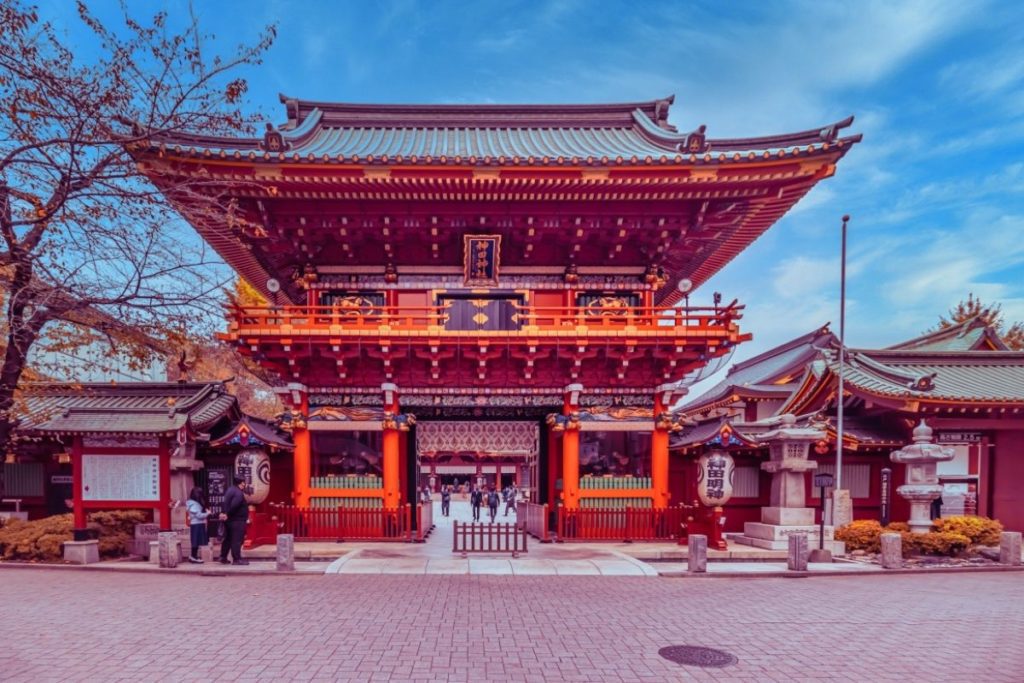Tokyo is a city full of religious sites and history. Here are 10 of the most famous shrines in Tokyo that you should visit on your trip. These shrines have played important roles in Japanese culture and history and are must-see attractions for Tokyo tourists. So get ready and explore some of the most sacred places in Japan’s capital city!
Table of Contents
Introduction:
The 10 most famous shrines in Tokyo are called Tokyo Jissha. These 10 shrines are the most visited and the best shrines in Tokyo.
Besides, pilgrims visit these 10 famous shrines during their Tokyo religious tours.
Emperor Meiji selected these 10 shrines for the strategic location, which formed a strong barrier protection of central Tokyo.
It is good to mention that Shintoism and Buddhism are the main religion in Japan. Thus, these two religions are firmly connected and rooted together everywhere in Japan.
Ultimately, Shinto gods are different from other gods. For example, more than one god enshrine in a shrine.
Shrines are holy places in Japan.
In addition, shrines are related to the daily life of Japanese people. For example, people go to shrine for good luck or business prosperity.
Besides, the people of Japan also go to the shrine for several religious events and festivals.
According to the list of shrines, there are more than 80,000 small and big shrines in Japan. However, only about 1,450 shrines are located in Japan’s capital Tokyo.
10 famous shrines in Tokyo:
Among the 1,450 shrines, the 10 most famous shrines in Tokyo are below:
1) Oji Shrine
2) Hakusan Shrine
3)Kameido Shrine
4)Kanda Shrine
5) Nezu Shrine
6)Hikawa Shrine
7)Tomioka Hachimangu
8)Shinagawa Shrine
9)Hie Shrine
10)Shiba Daijingu Shrine
1) Oji Shrine:
The shrine is located in Kita City, near Oji Station. It’s one of the most famous Shrines in Tokyo as its designated cultural property.
Besides, the people of Tokyo also believe that the gods enshrine here are the deities who protect Tokyo.
Moreover, the Ginko Tree of the shrine is very famous among mothers. The tree has a history of raising children.
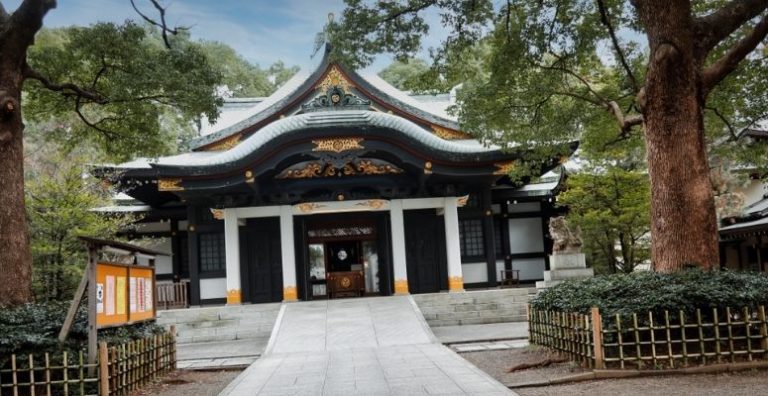
Oji Shrine is believed to be a blessing place for pregnant women, mothers, and newlyweds couples. People believe mothers get blessings from the shrine for their babies, and a ginkgo tree planted 700 years ago is the real witness.
At the same time, Oji Shrine is only a minute walk from the main road; however, if you go from the Kita Station through the shortcut, just a short walk.
Operation time:
9:00-17:00
Nearest Station: Oji Station
2 minutes walk from the station
Address:
1 Chome-1-12 Ojihoncho, Kita City, Tokyo 114-0022
Read more about Oji Shrine.
2) Hakusan Shrine:
Hakusan Shrine is a small beautiful shrine in the center of Bunkyo Ward. This ward is famous for many famous universities in Tokyo.
However, Shoguns supported this small Hakusan Shrine, which was selected as one of the most famous shrines.
As a result, it became a destination place for pilgrims and became one of the 10 most famous shrines in Tokyo. At the same time, this shrine bears a long political history, like Yasukuni Shrine.
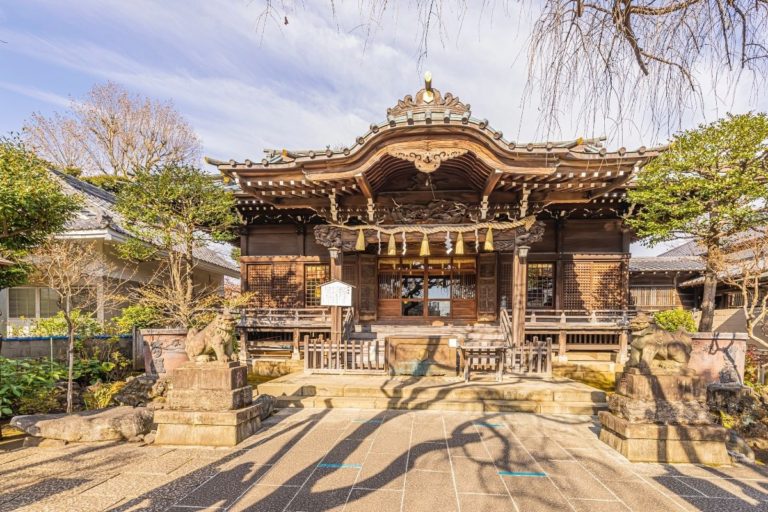
Besides, it is also the central place of Bunkyo Ajisai Matsuri, which is the major hydrangea festival in Tokyo. The shrine is a good photo spot with lovely hydrangea on the top of the Fujizuka.
The Fujizuka is not high. However, the top of Fujizuka is no less than a place of Tokyo Skyline to see around.
As a result, visitors love taking selfies here during their shrine visit. But the Fujizuka is a short walk from the main building.
Operation time:
24 hours
Nearest Station: Hakusan Station
2 minutes walk from the station
Address:
5 Chome-31-26 Hakusan, Bunkyo City, Tokyo 112-0001
Read more about Hakusan Shrine
3) Kameido Shrine:
The full name of the shrine is Kameido Tenjin Shrine, located in Shitamachi in Koto Ward. It was built in 1661.
Kameido Shrine is dedicated to a god who is believed to be a god of study, Michizane Sugawara.
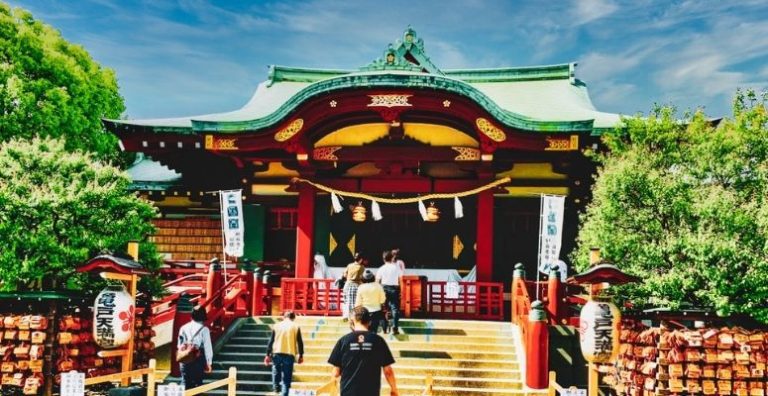
For this reason, Japanese students come here and write on ema (wish boards), wish for their entrance exams to success, and get accepted to the school they choose.
Moreover, the shrine is also famous for Wisteria Festival and Plug Festival.
The shrine is close to Kameido Central Park. It takes only 5 minutes on foot.
Operation time:
6:00-17:00
Nearest Station: Kinshicho Station and Kameido station
10 minutes walk from both stations
Address:
3 Chome-6-1 Kameido, Koto City, Tokyo 136-0071
Read more about Kameido Shrine
4) Kanda Shrine:
The shrine is locally known as Kanda Myojin Shrine in Sotokanda, Chiyoda City, Tokyo. Kanda Shrine is one of the most colorful shrines among the 10 most famous shrines in Tokyo.
The shrine is dedicated to three gods, Daikokuten Ebisu and Taira no Masakado no Mikoto. People worship these gods to bring good luck to their families and businesses.
The shrine is surrounded by beautiful outer buildings and many things to see around the temple grounds.
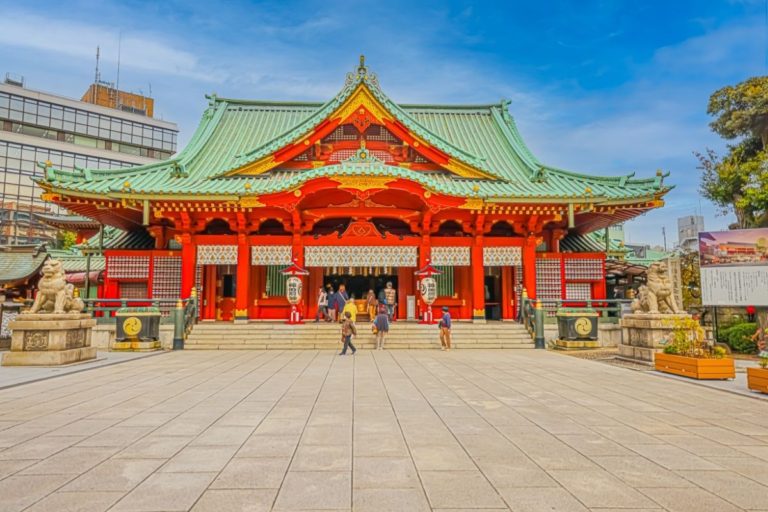
Therefore, Kanda Myojin Shrine is always busy with visitors.
In addition, famous Japanese Sake Companies dedicate their sake to this shrine for business success. Therefore, there are a few sakes packages near the main entrance.
Operation time:
Opens 24:00
Access:
Nearest Station: Ochanomizu Station
5 minutes walk from the station
Address:
2 Chome-16-2 Sotokanda, Chiyoda City, Tokyo 101-0021
Read more about Kanda Shrine
5) Nezu Shrine:
Nezu Shrine is located in Bunkyo Ward, a ward famous for Japanese universities. It’s one of the popular places for Azalea lovers.
Some bloggers describe it as being the most beautiful shrine in Tokyo. It became a National Cultural Property.
In addition, the shrine has a long tori path with 1,000 torii, and visitors can walk through it.
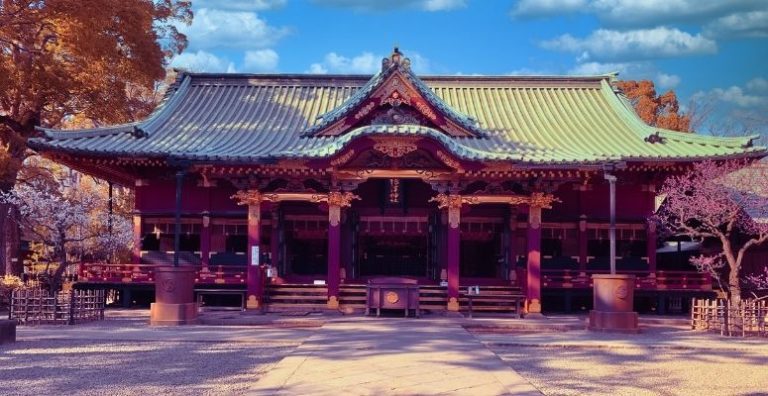
The shrine holds several festivals every year.
However, the most famous festival of the shrine is Azalea Festival or Tsutsuji Matsuri. The full blooming season is from early April to mid-May.
Operation time:
9:00 to 17:00
Access:
Nearest Station:
Nezu Station/Todai-Mae Station/Sendagi Station
5 minutes walk from the station
Address:
1 Chome-28-9 Nezu, Bunkyo City, Tokyo 113-0031
Read more about Nezu Shrine.
6) Hikawa Shrine:
It is familiar as Akasaka Hikawa Shrine, located in Akasaka, Minato Ward, Tokyo, Japan.
The shrine is one of the 59 branches of the Hikawa Jinja, designated as the main shrine for the former Musashi Province.
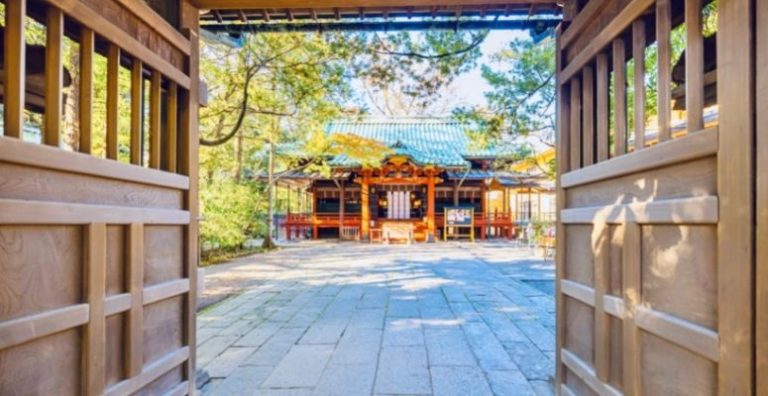
People go to the shrine to wish for romance, peace, prosperity, and business success. The shrine has a tranquil environment with tall trees around it.
Operation time:
6:00-17:30
Access:
Nearest Station: Roppongi Station
5 minutes walk from the station
Address:
6 Chome-10-12 Akasaka, Minato City, Tokyo 107-0052
Official website:
Read more about Hikawa Shrine
7) Tomioka Hachimangu:
Tomioka Hachimangu Shrine is located in Tomioka, Koto City, Tokyo, Japan. It’s the biggest Hachiman Shrine in Tokyo.
It is one of the most famous shrines in Japanese history. Moreover, Sumo Wrestling started at this shrine in Edo Period.
The shrine was the first place where Shogun started Sumo tournaments during the Edo Period. The shrine preserves a big sumo monument in the shrine’s precinct to keep its mark as the first place of the sumo.
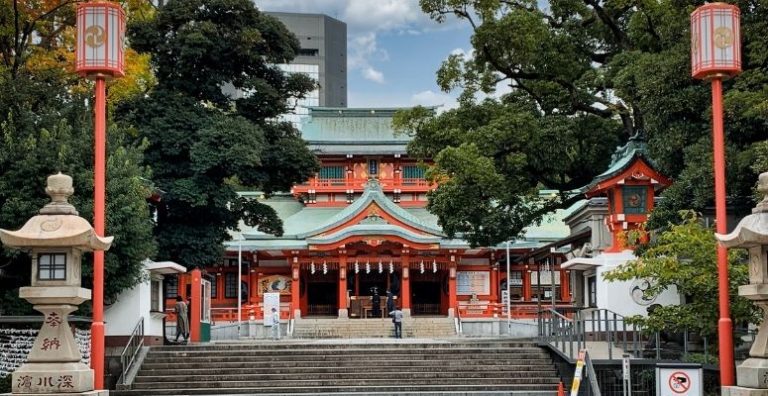
Moreover, the first Iron Bridge of Japan is located here. Therefore, in the autumn season, the surrounding of the bridge becomes more beautiful with autumn foliage.
On the other hand, it’s also famous during Cherry blooming season. The main entrance gate becomes white with lovely Cherry blossoms.
However, this shrine is very famous for its antique market. Every month antique market takes place on the shrine ground and attracts people.
Operation time:
Opens 24:00
Access:
Closest Station: Monzen-Nakamachi Station
3 minutes walk from the station
Address:
1 Chome-20-3 Tomioka, Koto City, Tokyo 135-0047
Read more about Tomioka Hachimangu
8) Shinagawa Shrine:
Shinagawa Shrine is located in Kitashinagawa, Shinagawa Ward, Tokyo.
Tokugawa Ieyasu prayed for his victory during the war at this shrine.
Shinagawa Shrine is dedicated to Daitokuten. This shrine is a beautiful spot to enjoy Japanese culture during the annual festival.
Daitokuten is one of the Seven Deities of good luck in the Tokai area. People visit it to wish them good luck.
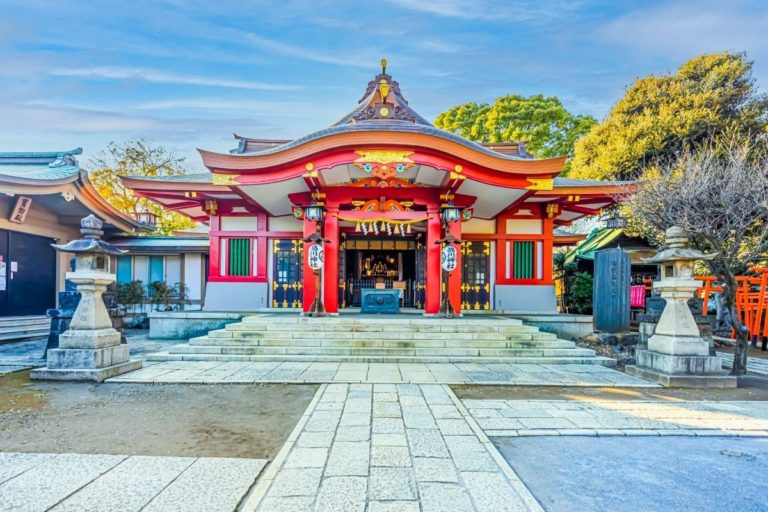
People worship here like other shrines putting yen coins into the offering box with a devoted mind. Visitors can learn from far as a narrow path leads from stairs to the main hall.
Besides, there is a Fujizuka, a miniature of Mount Fuji, which is 15 meters tall.
Operation time:
9:00-17:00
Access:
Nearest Station: Shim-Baba Station
2 minutes walk from the station
Address:
3 Chome-7-15 Kitashinagawa, Shinagawa City, Tokyo 140-0001
Official website:
Read more about Shinagawa Shrine
9) Hie Shrine:
It is a lovely shrine.
Hie Shrine is located in Nagatacho, Chiyoda City, Tokyo.
Moreover, it’s one of the most well-known sites among the 10 most famous shrines in Tokyo. The Main Hall is wonderfully beautiful.
Besides, the shrine has a long torii tunnel with many red torii gates. The red torii gates may help you understand why the Shogun chose it as one of the protector shrines during the Edo Period.
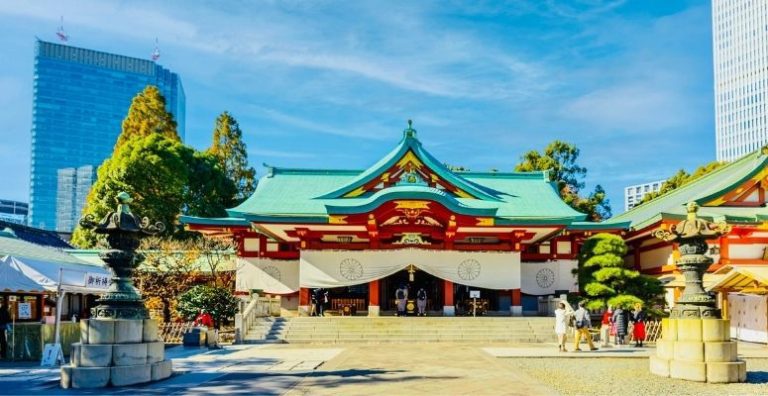
The shrine is famous for family-related good luck. Many families visit the shrine with their kids for good fortune.
People go there to pray for weddings, good married life, and easy childbirth.
Therefore, the front space of the shrine is always full of people, mostly married couples.
However, the most famous festivals are Children’s Celebration Day(Shichi-go-san) and Sanno Festival. In addition, Hie Shrine has a lovely Tori Tunnel like Nezu Shrine.
Operation time:
(Apr-Sep) 5:00 to 18:00
(Oct-Mar) 6:00 to 17:00
Access:
Nearest Stations:
Akasaka Station /Tameike-sanno Station
3 minutes walk from both stations
Address:
2 Chome-10-5 Nagatacho, Chiyoda City, Tokyo 100-0014
See my ultimate guide about Hie Shrine
10)Shiba Daijingu Shrine:
It’s one of the small shrines in Shibadaimon in Minato Ward, famous for relations and business but famous for its significance. Many call it Tokyo Daijingu Shrine.
Many local and international tourists visit the shrine to wish for success in relations and business.
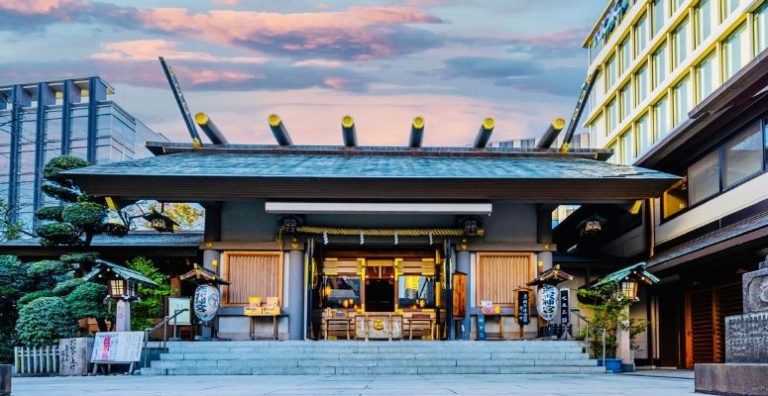
It is dedicated to Ise Grand Shrine’s two main deities, the sun goddess( Amaterasu-Omikami ) and the god of agriculture & industry(Toyoukeno-Okami).
Besides, the shrine is near Zozoji Temple and Tokyo Tower.
Opening hours:
5:30-6:30
Access:
Nearest Station: Daimon Station
2 minutes walk from the station
Address:
1 Chome-12-7 Shibadaimon, Minato City, Tokyo 105-0012
Official website:
Final word:
While you are in Tokyo, be sure to visit these famous shrines. Each shrine has its own unique history and charm that makes it worth a visit. And who knows, you would be lucky and get a chance to see a traditional Japanese wedding ceremony.
Of course, if you want to see the current influential shrine rather than Edo Period, then head to Meiji Shrine(Meiji Jingu). This Meiji Jingu Shrine is dedicated to Emperor Meiji and Empress Shoken.
Get off Harajuku Stations and walk 2 minutes towards Meiji Shrine’s main entrance. (Find out it on Google Maps from your current location).
However, if you like to visit other Buddhist Temples, try Sensoji Temple and Gotokuji Temple. Almost the same number of people visit Sensoji Temple in Taito City as Kyoto’s famous Fushimi Inari Taisha during Hatsumode every year.
Book reasonable Hotels in Tokyo:
Book cheap flight:
